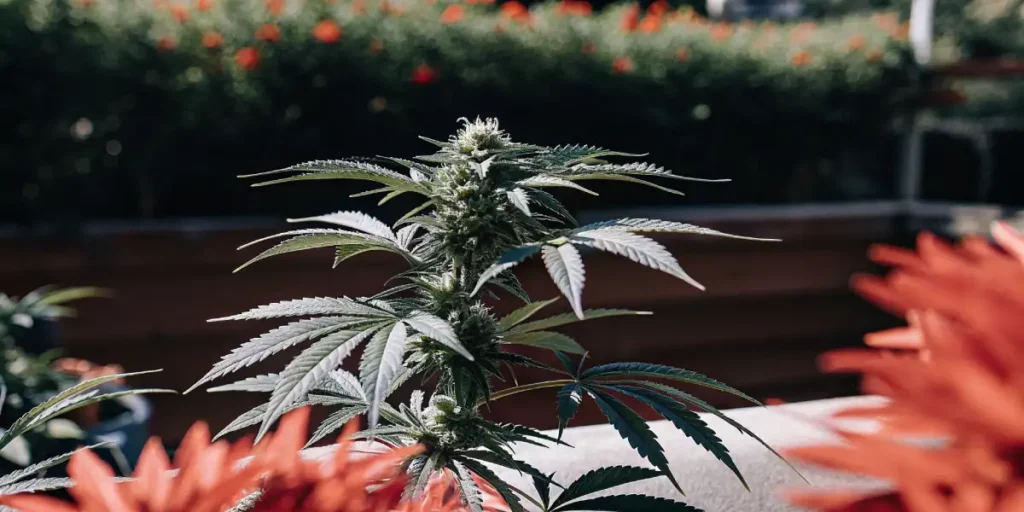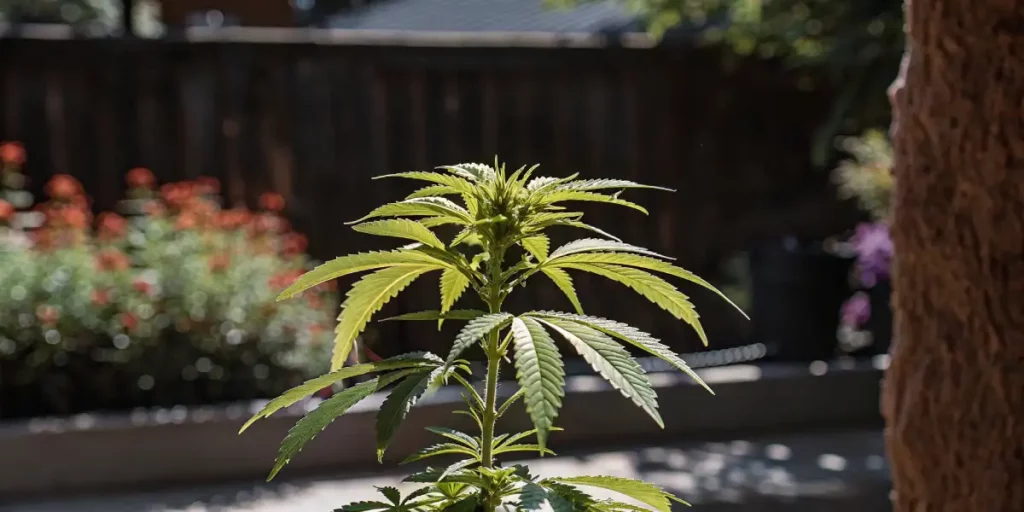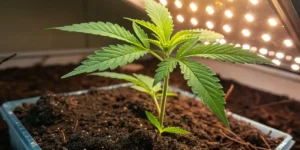Growing cannabis is an adventure. Whether you’re a newbie or a veteran, the question “is it safe to put autoflowers outside” often pops up. Autoflowering strains have unique traits. They bloom based on age, not light cycle. This makes them a popular choice for outdoor growing.
Outdoor cultivation offers several perks. Natural sunlight, fresh air, and more space can boost your plants’ growth. But, is it safe to put autoflowers cannabis outside? Yes, with the right conditions and care, your autoflowers can thrive outdoors.
Think about the optimal outdoor conditions for autoflower strains. These include the right climate, protection from pests, and smart planting tactics. Let’s dive into these aspects to ensure your success.
Optimal Outdoor Conditions for Autoflower Strains
Autoflowers are resilient. They’re designed to survive various environments. Still, the best climate for outdoor autoflower cannabis makes a big difference. Mild temperatures, between 70-85°F, are ideal. Avoid extreme cold or heat, as they can stress your plants.
Light is crucial. Autoflowers need plenty of direct sunlight. Aim for at least 12 hours a day. This will ensure they grow strong and healthy. Always pick a spot in your garden where they can soak up the sun.
The quality of soil is another factor that contributes to the optimal outdoor conditions for autoflower strains. Well-draining soil rich in organic matter will provide the necessary nutrients and prevent root rot. Testing your soil’s pH and adjusting it to be slightly acidic, around 6.0-7.0, can enhance your plants’ nutrient uptake.
Watering practices also play a role in the success of outdoor autoflowers. While they require consistent moisture, overwatering can be detrimental. Allowing the top inch of soil to dry out before watering again encourages healthy root growth. Mulching can help maintain soil moisture and regulate temperature, creating a stable environment for your plants.
Weather Considerations for Outdoor Autoflowers
Weather plays a huge role when growing outside. Many growers ask, is it safe to put autoflowers outside? Autoflowers can handle some rain, but too much can lead to mold. If your area is prone to heavy rain, think about using a simple plastic cover. It can shield your plants from downpours.
Wind is another factor. While a breeze strengthens stems, strong winds can damage them. Consider planting near a natural windbreak, like a fence or shrubs. This gives your autoflowers a fighting chance against harsh gusts.
Temperature fluctuations are a common weather consideration for outdoor autoflowers. Sudden drops in temperature, especially at night, can slow growth or cause stress. Using row covers or cloches can help trap heat and protect your plants during unexpected cold snaps, ensuring they remain in the best climate for outdoor autoflower cannabis.
Monitoring local weather forecasts can help you anticipate and prepare for sudden changes. During periods of drought, regular watering becomes even more crucial. Conversely, in prolonged wet conditions, ensuring your plants have adequate airflow and drainage will prevent mold and root issues.

Is it safe to put autoflowers outside? Protecting your outdoor grow from pests
Plants outside are more exposed to pests. Protecting outdoor autoflowers from pests needs a proactive approach. Regular inspections help catch issues early. Look for signs like yellowing leaves or small holes.
Natural predators, like ladybugs, can help control pest populations. You can also use organic pesticides if needed. Avoid harsh chemicals. They can harm your plants and the environment.
Companion planting is a great strategy for protecting outdoor autoflowers from pests. By planting pest-repelling plants like garlic, chives, or dill near your cannabis, you can deter unwanted insects naturally. These companions not only enhance your garden’s biodiversity but also support a healthier ecosystem for your autoflowers.
Another effective method is to use physical barriers. Applying a fine mesh or netting over your plants can prevent larger pests like birds and rodents from accessing your crops. Additionally, keeping your garden area clean and free of debris reduces hiding spots for pests, further protecting your autoflowers.
Outdoor Autoflower Planting Tips
Planning is key. Choose a location with good soil drainage. Waterlogged soil can lead to root rot. If drainage is poor, consider raised beds or pots with drainage holes.
Companion planting is a smart strategy. Plants like basil or marigold can naturally repel pests. Plus, they add beauty to your garden. Just make sure they don’t overshadow your cannabis.
When considering outdoor autoflower planting tips, timing is critical. Is it safe to put autoflowers outside? Yes—planting after the last frost date in your region ensures your seedlings aren’t exposed to cold stress. Using a gardening calendar can help you plan your planting schedule effectively, optimizing the growing season.
Another tip is to gradually acclimate your plants to outdoor conditions. This process, known as hardening off, involves exposing your seedlings to outdoor elements gradually over a week. By slowly increasing their time outside, you’ll strengthen their resilience and prepare them for the challenges of outdoor growing.
Best Climate for Outdoor Autoflower Cannabis
Different strains prefer different climates. Choosing the right strain for your climate boosts your chances of success. If you live in a cooler area, consider the Blueberry Autoflower from Global Green Genetics. It’s hardy and adapts well to varying temperatures.
+In warmer climates, the Amnesia Haze Autoflower is a great choice. It loves sunshine and can handle heat better than other strains. Always match your strain to your local weather for the best results.
When determining the best climate for outdoor autoflower cannabis, consider the length of your growing season. Some strains have shorter flowering times, making them ideal for regions with shorter summers. Conversely, longer flowering strains thrive in areas with extended warm periods.
Microclimates within your garden can also influence plant growth. Observing how sunlight moves across your space can help you identify the sunniest spots for planting. Adjusting to these microclimates ensures your autoflowers receive the optimal amount of light and warmth throughout the day.
Real-Life Examples of Successful Outdoor Autoflower Grows
Many growers have found success with outdoor autoflowers. One grower in California reported great results with Amnesia Haze. Despite hot summer days, the plants flourished with ample sunlight and regular watering. For those wondering, is it safe to put autoflowers outside, this example shows that with the right conditions, outdoor growing can be highly effective.
In contrast, a grower in Oregon used Northern Lights Autoflower. Despite cooler and wetter weather, the strain thrived. The grower used raised beds to prevent waterlogging, ensuring healthy roots.
Another grower in the Midwest managed to achieve a bountiful harvest despite unpredictable weather patterns. By selecting the Jack Herer Autoflower, known for its adaptability, and implementing proactive weather considerations for outdoor autoflowers, they successfully navigated both heatwaves and unexpected rain.
A Southern gardener reported impressive results with the White Widow Autoflower. This strain’s robust nature allowed it to withstand the region’s high humidity and occasional storms. By carefully monitoring and adjusting humidity levels, they maintained a healthy environment that prevented mold and mildew.

FAQs of is it safe to put autoflowers outside
Is it safe to put autoflowers outside? How to start growing them outdoors
Starting with quality seeds is essential. Visit Global Green Genetics for reliable options. Choose a strain suited to your climate. Prepare a sunny spot with well-draining soil. Many growers ask, is it safe to put autoflowers outside? The answer depends on timing and conditions. Start your seeds indoors if temperatures are still cool. Once they sprout and the weather stabilizes, transplant them outside.
Focus on maintaining optimal conditions. Ensure they get enough sunlight and water. Keep an eye on the weather and be ready to protect them from pests and extreme conditions. Regular monitoring and care will set you on the path to a successful harvest.
Besides to selecting the right seeds, knowing the growth stages of autoflowers can improve your growing skills. Familiarize yourself with the vegetative and flowering phases, and adjust your care accordingly. For instance, during the flowering stage, your plants will need slightly different nutrients to support bud development.
Using a journal to track your growing progress can be invaluable. Recording observations, weather patterns, and care routines helps you make informed decisions and adjust your techniques for future outdoor autoflower planting tips.
What are common mistakes when growing autoflowers outside?
One common mistake is not considering the local climate. Planting a strain unsuitable for your area’s weather can lead to poor growth. Another mistake is overwatering. Autoflowers need less water than you might think. Ensure the soil dries out slightly between waterings.
Neglecting pests can also be detrimental. Regular inspections and preventative measures can save your plants from damage. Lastly, don’t underestimate the importance of sunlight. Make sure your plants aren’t shaded by buildings or trees.
Another mistake is planting too closely together. Crowded plants compete for light, water, and nutrients, which can stunt their growth. Ensuring enough space between plants allows for better airflow and access to sunlight, which are crucial for healthy development.
Ignoring soil quality is a common oversight. Using poor soil can lead to nutrient deficiencies and weak plants. Investing in high-quality potting mix or amending your garden soil with organic matter can significantly impact your autoflowers’ health and yield.
Can autoflowers survive in harsh weather conditions?
Autoflowers are generally resilient, but extreme weather can pose challenges. They handle mild fluctuations in temperature and humidity well. However, harsh conditions like frost, extreme heat, or heavy storms can stress or even kill them.
To help them survive, use protective measures. For instance, during unexpected frosts, consider using frost cloths. In extreme heat, provide shade during the hottest part of the day. Always be prepared to adapt your strategy based on the weather.
In regions with high winds, securing your plants with stakes can prevent damage. This physical support helps them withstand gusts, keeping them upright and stable. Combining this with planting near windbreaks enhances their protection.
In coastal areas where salt spray can be an issue, rinsing your plants with fresh water can prevent salt buildup. This simple step can mitigate stress and keep your autoflowers in optimal health despite challenging conditions.
What is the best time of year to plant autoflowers outside?
The best planting time largely depends on your local climate. In general, aim for late spring when the risk of frost has passed. This gives your plants the longest period of favorable weather to grow and mature.
If you live in a warmer climate, you might have more flexibility, allowing for multiple planting cycles per year. However, many growers ask, is it safe to put autoflowers outside? The answer depends on your environment. Always monitor weather patterns and plan your planting to avoid any extreme conditions during the growth cycle.
In regions with short growing seasons, consider starting your seeds indoors to give them a head start. Once they are robust enough and the outdoor conditions are suitable, transplanting them outside can maximize their growth potential.
For those in tropical climates, where the growing season is almost year-round, staggered planting can ensure a continuous harvest. By planting in intervals, you can enjoy a steady supply of cannabis throughout the year.
How do I protect my outdoor autoflowers from animals?
Animals like deer, rabbits, and rodents can pose a threat to outdoor cannabis plants. To deter them, consider using physical barriers like fences. Netting or chicken wire around your garden can keep larger animals at bay. If you’re wondering, is it safe to put autoflowers outside, protecting your plants from wildlife is a crucial part of ensuring their safety and successful growth.
For smaller pests, natural repellents can be effective. Planting herbs like mint or lavender nearby can also help. These plants emit scents that many animals find unpleasant, providing a natural deterrent without harming your cannabis.
Motion-activated sprinklers are another effective deterrent against animals. The sudden burst of water can scare off intruders without harming them, offering a humane way to protect your autoflowers from unwanted visitors.
Applying organic animal repellents around the perimeter of your garden can also work wonders. These products are usually made from natural ingredients and can help create a boundary that animals are hesitant to cross.





